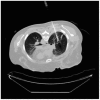Thoracic intervention and surgery to cure lung cancer: image-guided thermal ablation in primary lung cancer
- PMID: 29532709
- PMCID: PMC6552388
- DOI: 10.1177/0141076818763335
Thoracic intervention and surgery to cure lung cancer: image-guided thermal ablation in primary lung cancer
Figures





Similar articles
-
Percutaneous ablation of malignant thoracic tumors.JBR-BTR. 2013 May-Jun;96(3):142-54. doi: 10.5334/jbr-btr.235. JBR-BTR. 2013. PMID: 23971170
-
Image-guided lung tumor ablation: principle, technique, and current status.J Chin Med Assoc. 2013 Jun;76(6):303-11. doi: 10.1016/j.jcma.2013.03.004. Epub 2013 Apr 20. J Chin Med Assoc. 2013. PMID: 23608075 Review.
-
Clinical practice guidelines on image-guided thermal ablation of primary and metastatic lung tumors (2022 edition).J Cancer Res Ther. 2022 Sep;18(5):1213-1230. doi: 10.4103/jcrt.jcrt_880_22. J Cancer Res Ther. 2022. PMID: 36204866 Review.
-
The efficacy of electromagnetic navigation to assist with computed tomography-guided percutaneous thermal ablation of lung tumors.Innovations (Phila). 2012 May-Jun;7(3):187-90. doi: 10.1097/IMI.0b013e318265b127. Innovations (Phila). 2012. PMID: 22885459 Clinical Trial.
-
Image-guided percutaneous ablation of lung malignancies: A minimally invasive alternative for nonsurgical patients or unresectable tumors.J Bronchology Interv Pulmonol. 2014 Jan;21(1):68-81. doi: 10.1097/LBR.0000000000000008. J Bronchology Interv Pulmonol. 2014. PMID: 24419192 Review.
Cited by
-
Image-guided percutaneous ablation for lung malignancies.Front Oncol. 2022 Nov 10;12:1020296. doi: 10.3389/fonc.2022.1020296. eCollection 2022. Front Oncol. 2022. PMID: 36439490 Free PMC article. Review.
-
Algorithm of Pulmonary Vascular Segment and Centerline Extraction.Comput Math Methods Med. 2021 Aug 25;2021:3859386. doi: 10.1155/2021/3859386. eCollection 2021. Comput Math Methods Med. 2021. PMID: 34484415 Free PMC article.
-
Data sharing and opening up research.J R Soc Med. 2019 Jun;112(6):211. doi: 10.1177/0141076819855176. J R Soc Med. 2019. PMID: 31163119 Free PMC article. Review. No abstract available.
-
Exploring the impact of variable power outputs on the efficacy and safety during microwave ablation for lung carcinoma: a real-world study.J Thorac Dis. 2024 Aug 31;16(8):5031-5041. doi: 10.21037/jtd-24-557. Epub 2024 Aug 28. J Thorac Dis. 2024. PMID: 39268093 Free PMC article.
-
[Research Progress of Treatment for NSCLC in Young Patients].Zhongguo Fei Ai Za Zhi. 2022 Dec 20;25(12):888-894. doi: 10.3779/j.issn.1009-3419.2022.102.48. Zhongguo Fei Ai Za Zhi. 2022. PMID: 36617475 Free PMC article. Review. Chinese.
References
-
- Vogl TJ, Naguib NNN, Gruber-Rouh T, Koitka K, Lehnert T, Nour-Eldin NE. Microwave ablation therapy: clinical utility in treatment of pulmonary metastases. Radiology 2011; 261: 643–651. - PubMed
-
- Belfiore G, Ronza F, Belfiore MP, Serai N, di Ronza G, Grassi R, et al. Patients' survival in lung malignancies treated by microwave ablation: our experience on 56 patients. Eur J Radiol 2013; 82: 177–181. - PubMed
-
- Wolf FJ, Grand DJ, Machan JT, Dipetrillo TA, Mayo-Smith WW, Dupuy DE. Microwave ablation of lung malignancies: effectiveness, CT findings, and safety in 50 patients. Radiology 2008; 247: 871–879. - PubMed
-
- National Institute for Health and Care Excellence. Microwave ablation for treating primary lung cancer and metastases in the lung (IPG469), London: National Institute for Health and Care Excellence, 2013.
Publication types
MeSH terms
LinkOut - more resources
Full Text Sources
Other Literature Sources
Medical

